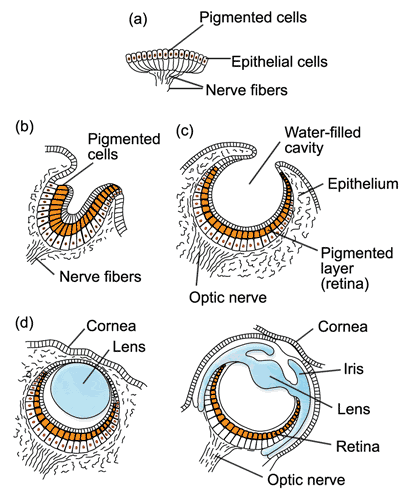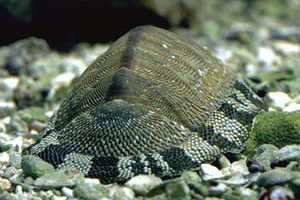The last resort defense of the fallacy the appeal to ignorance without understanding what your talking about because of a religious agenda based on mythology.
The existence of simple primitive eyes eyes and light sensitive cells that are precursor of eyes are present in today's organisms and the associated genetics. It is obvious that these would not be preserved in the fossil record.
From:
Molluscs (Mollusca)
The Evolution of the Mollusc Eye
Stages in the evolution of eyes among molluscs. Source:
Wikipedia.
a: Flat eye; b: cup eye; c: pinhole eye; d: vesicular eye; e: lens eye.
The example of the molluscs offers a good opportunity to observe the evolution of light sense organs in the animal kingdom. Among the numerous and various groups of molluscs there are primordial and advanced, movable and sessile species.
In the most primitive form light perception happens by single sense cells located somewhere in the body. Singular light sense cells dispersed over the body surface, as on snails and segmented worms, can tell the difference between light and dark, so the animal may benefit from a shadow reflex to protect itself against predators. They are, however, not a sense organ in the common sense of speaking: A sense organ is a complete organ, not just singular cells, specialized in a defined sensory performance. The first light sense organ is a specialized field of light sense cells and pigment cells for lateral isolation. It is called a flat eye. It enables its possessor to differentiate between light and dark, but only basically makes it possible to tell where the light comes from.
Flat eyes today can still be found in primitive groups of invertebrates, such as jellyfish (
Coelenterata). It may also be assumed that the molluscs' ancestors, primitive, worm-like ground-living creatures, also possessed such flat eyes.
A primitive flat eye may be of valuable use to an animal either sessile or moving passively. The directed movement of more highly developed molluscs required the formation of more advanced light sense organs. In the consequence the light-sensitive epithelium of the flat eye caved in to form a pit. So the light sense cells on facing sides of the eye can tell apart light and shade. That makes it possible to determine where the light comes from. Pit shaped eyes can be found in sessile and slow moving invertebrates.
In adaptation to a directed movement there was not only an evolution of eyes, but also a change in body form: Sense organs became concentrated at the end of the body facing towards the the main direction of movement: The head evolved as the centre of sensory activity (cephalization).
While a pit eye may be able to differentiate between light and shade, it is not capable of producing pictures. Especially for predatory molluscs, having to observe and to follow their prey, an improvement of the eye's picture projection capability was necessary: The eye opening narrowed, and in consequence the picture projected on the retina became more focused. So the pigmented cup eye came into existence. Today, in its primitive state, this type of eye can be found among certain
bivalves and turbellarian worms.
A chiton. Source:
Invertébrés Herbivores.
Pigmented cup eyes can also be found among primitive, mainly sessile, gastropods, such as
limpets (
Patellidae).
Comparable to the pigmented cup eyes of primitive gastropods are the
cuticular eyes of chitons (
Polyplacophora). Those, as their name states, are situated in the dorsal shell plates of the chiton and enable the animal to tell apart light and shadow on its dorsal side.
In the further course of evolution, the eye opening reduced in size and as a result the eye achieved abilities comparable to a so-called pinhole camera: A focused, but low-light picture can be projected to the retina. Among the molluscs, pinhole eyes can be found among ormers (
Haliotidae) and primitive cephalopods, such as
Nautilus. Nautilus is a living fossil, a remnant from the Mesozoic. It is also assumed, that fossil cephalopods, such as the giant endocerate
Cameraceras from the Ordovician had similar eyes.
See: Nigel Marven's "
Walking with dinosaurs: Sea Monsters"
In the pit eye and the pinhole eye, the inner space of the eye is filled by a secretion breaking the light rays and, at least basically, enhancing brightness and focus of the picture. This inner eye space could evolve noticeably, when the eye opening of the pinhole eye closed completely and was covered by a translucent epithelium. Among more highly developed snails, especially carnivorous sea gastropods, this liquid-filled bubble inside the eye became a primitive lens, making possible the perception of a relatively focused picture with a usable brightness (in contrary to the pinhole eye, in which focus always works at the expense of brightness)."




